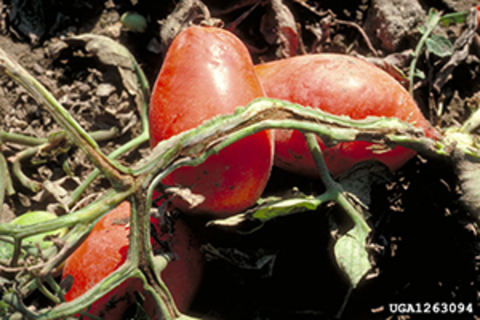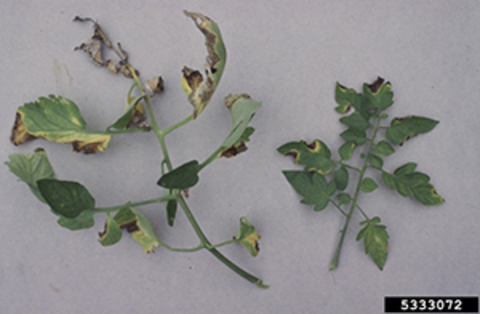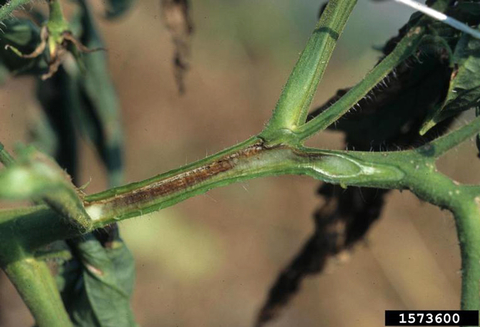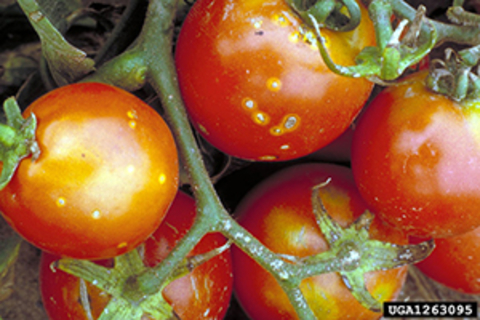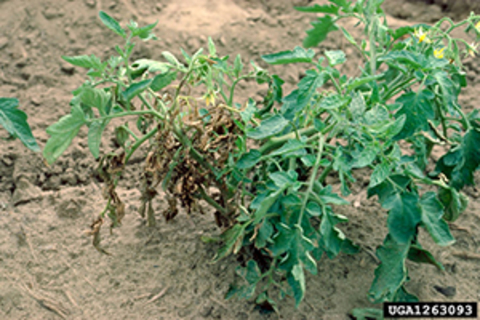Quick facts
- Bacterial canker is primarily important on tomato.
- This bacterial disease is suspected to be seedborne, and can survive in solanaceous weeds and decaying plant tissue.
- Disease symptoms can look different in the field than in high tunnels.
- Bacterial canker can persist in the soil for a long time, so focus on prevention.
- Transplant production is the key time to manage bacterial canker.
How to tell bacterial canker from other issues
- Symptoms vary with age of plant, type of infection, environment and other factors. This disease can be difficult to diagnose based on symptoms alone.
- Confirm diagnosis by sending a plant sample to the UMN Plant Disease Clinic.
Seedlings
- Small, white, raised spots may form on leaves.
- Leaf edge discoloration and wilting.
- Seedling completely wilts and dies.
Leaves
- Yellow to tan patches form between veins. Edges of leaf turn brown, with a yellow border.
- Veins on the leaves and petioles can become dark and sunken.This symptom does not always show up.
- Lower leaves wilt, often only on one side.
- Entire plant may collapse and die.
Stem
- Brown streaks can be seen in the vascular system when the stem is cut open.
- Stem splits, forming long, brown cankers.
- Yellow sticky fluid may emerge from cut stem when squeezed.
Fruit
- Fruit may have small (1/4 inch), raised, white spots with tan or brown centers (called bird's eye spot).
- Fruit surface may appear netted or marbled.
Biology
- The disease is caused by the bacterial pathogen Clavibacter michiganensis subspecies michiganensis.
- Warm temperatures (75 to 90°F), high moisture or relative humidity encourage disease development and spread.
- Infected seed or transplants spread the bacterial canker pathogen long distances and introduce it to new areas.
- The disease easily spreads between seedlings in a transplant production greenhouse through growers' hands, equipment, and during pruning and trellising of plants. One infected seed can result in many infected transplants, through which the disease can become established in high tunnels or fields.
- Transplants may be infected yet not initially show symptoms. In the field, infected transplants often die and secondary spread is limited or of little economic impact. In tunnels or greenhouses, the disease easily spreads between transplants and between older plants through practices like pruning and staking. This can result in severe symptoms and yield loss.
- The pathogen survives up to three years on non-decomposed tomato plant debris and can survive for several months on stakes and equipment, thereby readily infecting tomatoes planted in the same tunnel the following season.
Managing bacterial canker in home gardens
Look for leaves with spotting, especially during periods of wet, humid weather. Remove leaves with symptoms.
Cultural controls
- Plant tomatoes where no tomatoes, potatoes, peppers or eggplants have been for the past 3-4 years.
- If starting your own seeds, choose seeds from a reputable supplier
- If buying transplants, inspect transplants and choose plants without spots or discoloration
- Keep tomato leaves as dry as possible. Water with drip irrigation or a soaker hose. Water in the morning so leaves dry quickly in the sun.
- Space plants so that air flows between them. Staking or caging tomato plants helps, though make sure to clean and sanitize tomato stakes and cages each year.
- Remove or bury plants at the end of the season
Managing bacterial canker on farms
The conditions for bacterial canker spread are readily present in greenhouses, making transplant production a key window for management.
Scout regularly for wilting plants, yellowing leaf edges, and creamy white spots on leaves.
There are currently no tomato varieties with resistance to bacterial canker.
- Plant certified pathogen-free seed from a reputable supplier.
- Do not save seed from infected plants.
- Treat any saved seed prior to planting.
- Soak seeds in a solution of 1 part germicidal bleach to 4 parts water for 1 minute.
- Rinse in water for 5 minutes OR soak seed in 122°F water for 25 minutes.
- Neither method will completely eliminate the pathogen, so the seedling should be carefully monitored for symptoms.
- Purchase healthy transplants from a reputable grower. Avoid transplants that have been pruned or cut back as this procedure easily spreads the bacterial pathogen.
- Disinfect tools and equipment between seasons with a commercial greenhouse sanitizer according to label instructions or by soaking in a solution of 1 part germicidal bleach to 9 parts water for 1 to 5 minutes.
- Regularly clean pruning tools using a commercial greenhouse sanitizer or a 1:9 solution of bleach to water. To be efficient when pruning, have two pruners and alternate between them between plants to allow proper soaking time.
- Discard strings and wooden stakes. These materials cannot be cleaned because they are naturally porous, making it difficult for the sanitizer to reach the bacteria inside.
- Avoid working in fields when the foliage is wet with rain, irrigation or dew.
- In greenhouse or high tunnel production, promptly bag and remove infected plants, including roots to prevent spread. Remove the adjacent plants as well, even if they appear healthy.
- Remove or plow in remaining plant debris immediately after harvest to encourage decomposition.
- Infected plant debris can be composted on site . The pathogen will be killed if the compost heats up and all plant parts are completely broken down.
- Rotate away from tomato and related crops for two to three years.
- Control weeds in the Solanaceae family, like nightshades, as well as volunteer tomatoes or peppers during the rotation.
Remove symptomatic plants and plants next to them during transplant production. Research in Michigan and the Netherlands has shown bacterial canker can move through transplant trays.
Some greenhouse and high tunnel growers have switched to hydroponic tomato production in cases where the pathogen has built up in the soil and rotation is a challenge.
There are very few chemical options for managing bacterial canker. Sprays during transplant production are more effective in prevention than sprays post-transplanting or when symptoms appear in the field.
Visit the Midwestern Vegetable Production Guide for a current list of treatment options.
CAUTION: Mention of a pesticide or use of a pesticide label is for educational purposes only. Always follow the pesticide label directions attached to the pesticide container you are using. Be sure that the plant you wish to treat is listed on the label of the pesticide you intend to use. And observe the number of days between pesticide application and when you can harvest your crop. Remember, the label is the law.
Reviewed in 2024


